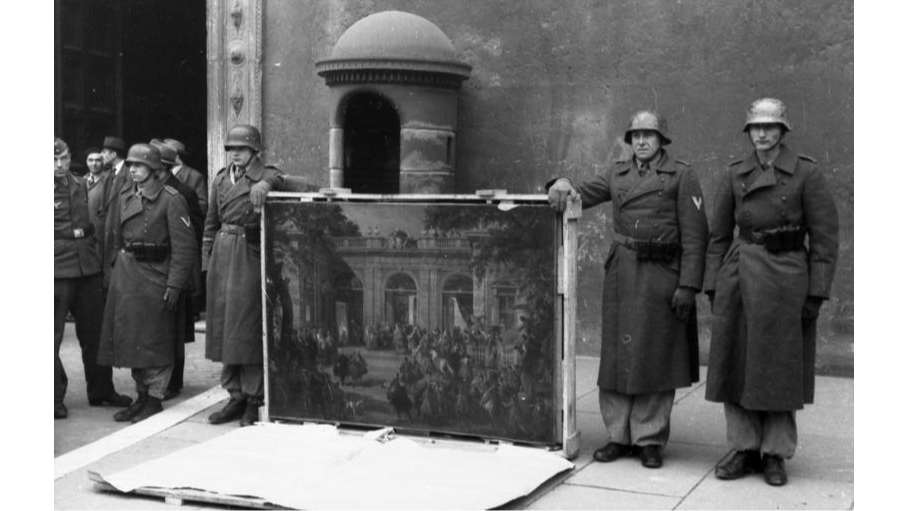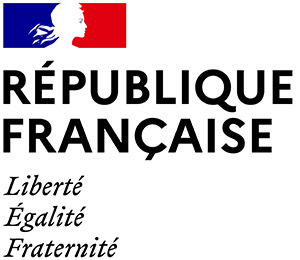
Les spoliations d’œuvres d'art pendant la Seconde Guerre mondiale et leur restitution Guide des recherches dans les archives
Spoliations et restitutions d’œuvres d'art : aperçu historique
Pendant la Seconde Guerre mondiale, un pillage du patrimoine artistique détenu par les Juifs (œuvres d’art, mais aussi bibliothèques et manuscrits, pianos, droits d’auteur, etc.) est organisé en France par l’occupant allemand et par le gouvernement de Vichy.
Ces spoliations débutent dès l’été 1940, sous l’égide de l’ambassade d’Allemagne à Paris. Puis, à partir de septembre 1940, elles sont principalement orchestrées par l’Einsatzstab Reichsleiter Rosenberg (ERR), chargé de la confiscation des biens culturels juifs et francs-maçons dans les territoires occupés par le Reich. Parallèlement, dès 1942, un pillage des appartements laissés vacants par les internements, les arrestations ou la fuite de leurs occupants est mis en œuvre par la Dienststelle Westen dans le cadre de la Möbel-Aktion. Le Devisenschutzkommando est quant à lui chargé de vider les coffres bancaires. On estime le bilan des saisies de l’ERR à l’encontre des collectionneurs et marchands d’art juifs à environ 20 000 œuvres, pillées chez plus de 200 personnes ou familles.
Le gouvernement de Vichy participe également à cette spoliation en mettant en œuvre une politique d’aryanisation visant à exclure les Juifs de tous les secteurs de l’économie et de la société. Le Commissariat général aux questions juives (CGQJ), institué par la loi du 29 mars 1941, nomme des administrateurs provisoires chargés de la gestion et de la vente des biens juifs. Les marchands d’art et d’antiquités et les collectionneurs privés sont bien sûr touchés par cette aryanisation.
Pourquoi ce guide des recherches ?
En 2013, le ministère de la Culture et de la Communication s’engage dans une nouvelle démarche proactive visant à restituer les MNR. Un « groupe de travail sur les provenances d’œuvres récupérées après la Seconde Guerre mondiale » est mis en place. Dans un rapport remis à la Ministre le 27 novembre 2014, il plaide notamment pour la mise au point d’un guide des recherches dans les archives des spoliations et des restitutions, l’objectif de ce guide étant d’actualiser l’ouvrage publié en 2000 sous la direction de Caroline Piketty dans le cadre de la Mission Mattéoli. Après concertation des Archives de France et la direction des archives du ministère des Affaires étrangères avec les membres du groupe de travail, le principe est arrêté de lancer une enquête recensant et décrivant les différents fonds conservés en France et susceptibles de fournir des informations liées à la spoliation et à la récupération des biens culturels.
Voir les pages de la Mission de recherche et de restitution des biens culturels spoliés entre 1933 et 1945 sur le site web du ministère de la Culture
Sommaire
Archives nationales
- Archives de l'administration allemande
Commandement militaire allemand en France. Archives du service de protection des œuvres d'art et du service de protection des devises (AJ/40)
- Archives de l'administration française
Commissariat général aux questions juives (AJ/38)
Administration des Beaux-Arts. Archives de cabinet et archives du bureau des Travaux d’art (F/21)
Les musées nationaux pendant la Seconde Guerre mondiale et l’évacuation des œuvres (20144792)
Contrôle des exportations d’œuvres d’art sous l’Occupation (20144657)
Dossiers de carrière des personnels scientifiques des Musées nationaux (20150497)
Les bibliothèques pendant la Seconde Guerre mondiale (19910531)
Commission de récupération artistique. Archives de la sous-commission des livres (F/17)
La récupération artistique à la direction des Musées de France (20150044)
Service de restitution des biens des victimes des lois et mesures de spoliation (AJ/38)
Centre de règlement des dommages de guerre de Paris. Dossiers de dommages de guerre mobiliers (19780332)
Commission nationale interprofessionnelle d'épuration (F/12)
- Archives judiciaires et d'avocats
Chambres civiques de la cour de justice du département de la Seine (Z/5)
Haute cour de justice (3W)
Fonds Maurice Garçon (19860089)
- Archives de galleries
Fonds Louis Carré (389AP)
- Archives de la Mission Mattéoli
Mission d'étude sur la spoliation des Juifs de France, dite « Mission Mattéoli » (F/60MLI)
Fonds Antoine Prost (550AP)
Archives diplomatiques
Services français de récupération artistique (209SUP)
Office des biens et intérêts privés. Service des spoliations allemandes en France (13BIP)
Office des biens et intérêts privés. Restitutions (22BIP)
Institut national d'histoire de l'art
- Archives de galleries et de collectionneurs
Fonds Fabius. Sous-fonds Élie Fabius (Archives 131)
Fonds Fabius. Sous-fonds Fabius Frères (Archives 131)
Archives de la Galerie Pierre (Archives 140)
Fonds Claude Roger-Marx (Archives 94) - Archives de chercheurs
Fonds César Mange de Hauke (Archives 36)
Fonds Paul-André Lemoisne (Archives 69)
Service historique de la Défense
Ministère de la Guerre. Section culturelle de la direction générale des études et recherches
Préfecture de police de Paris
Préfecture de police de Paris. Œuvres d'art saisies par les autorités allemandes en juin et juillet 1940 (BA 2436)
Renseignements généraux. Dossier individuel sur Germain Ducher (77 W 5371)
Préfecture de police de Paris. Dossiers d'épuration (KB 69)
Mémorial de la Shoah
Commissariat général aux questions juives
Ambassade d'Allemagne à Paris
Dossier Otto Abetz
État-major allemand en France
Tribunal militaire international. Procès de Nuremberg
Musée du château et domaine national de Compiègne
Exposition à Compiègne des œuvres de la Récupération artistique
Bibliographie
Bibliographie sélective et ressources en ligne

